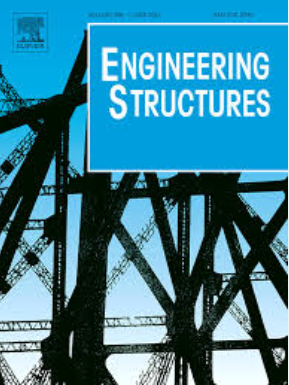温克勒弹性地基上仿生螺旋层合复合材料环形扇形板静振动特性研究
IF 6.4
1区 工程技术
Q1 ENGINEERING, CIVIL
引用次数: 0
摘要
本研究旨在通过研究Winkler弹性支撑下螺旋层合复合材料环形扇形板的静态行为和固有频率特性,探讨仿生螺旋层合在环形扇形板中的适用性。利用基于一阶剪切变形理论(FSDT)的有限元数值模型,对这些结构的力学响应进行了全面的研究。几种仿生叠层结构,包括线性、斐波那契、递归、指数和半圆形螺旋设计,分析和比较了传统的叠层模式,如单向、交叉层和准各向同性层压板。本文通过表格和图形数据展示了数值结果,突出了铺层构型、层数、半径和厚度比、扇形角、边界条件和winkler型弹性支撑对这些仿生复合材料的静态和固有频率响应的影响。本研究的结果提供了螺旋结构模式和成熟的层压模型之间的全面比较,突出了生物启发螺旋结构在薄壁复合材料结构中的显着优势。本文章由计算机程序翻译,如有差异,请以英文原文为准。
Static and vibrational characteristics of bio-inspired helicoid laminated composite annular sector plates embedded on Winkler elastic foundation
This research aims to investigate the applicability of bio-inspired helicoidal lamination in annular sector plates by examining the static behavior and natural frequency characteristics of helicoidally laminated composite annular sector plates subjected to Winkler elastic support. Using a finite element numerical model based on first-order shear deformation theory (FSDT), the mechanical responses of these structures are thoroughly examined. Several bio-inspired lay-up configurations, including linear, Fibonacci, recursive, exponential, and semicircular helicoidal designs, are analyzed and compared with traditional stacking patterns such as unidirectional, cross-ply, and quasi-isotropic laminates. This paper presents numerical results, illustrated through tabular and graphical data, highlighting the effects of lay-up configurations, number of layers, radius and thickness ratios, sector angles, boundary conditions, and Winkler-type elastic support on the static and natural frequency responses of these bio-inspired composites. The findings of this study provide a comprehensive comparison between helicoidal configuration patterns and well-established lamination models, highlighting the notable advantages of the bio-inspired helicoidal patterns in thin-walled composite structures.
求助全文
通过发布文献求助,成功后即可免费获取论文全文。
去求助
来源期刊

Engineering Structures
工程技术-工程:土木
CiteScore
10.20
自引率
14.50%
发文量
1385
审稿时长
67 days
期刊介绍:
Engineering Structures provides a forum for a broad blend of scientific and technical papers to reflect the evolving needs of the structural engineering and structural mechanics communities. Particularly welcome are contributions dealing with applications of structural engineering and mechanics principles in all areas of technology. The journal aspires to a broad and integrated coverage of the effects of dynamic loadings and of the modelling techniques whereby the structural response to these loadings may be computed.
The scope of Engineering Structures encompasses, but is not restricted to, the following areas: infrastructure engineering; earthquake engineering; structure-fluid-soil interaction; wind engineering; fire engineering; blast engineering; structural reliability/stability; life assessment/integrity; structural health monitoring; multi-hazard engineering; structural dynamics; optimization; expert systems; experimental modelling; performance-based design; multiscale analysis; value engineering.
Topics of interest include: tall buildings; innovative structures; environmentally responsive structures; bridges; stadiums; commercial and public buildings; transmission towers; television and telecommunication masts; foldable structures; cooling towers; plates and shells; suspension structures; protective structures; smart structures; nuclear reactors; dams; pressure vessels; pipelines; tunnels.
Engineering Structures also publishes review articles, short communications and discussions, book reviews, and a diary on international events related to any aspect of structural engineering.
 求助内容:
求助内容: 应助结果提醒方式:
应助结果提醒方式:


